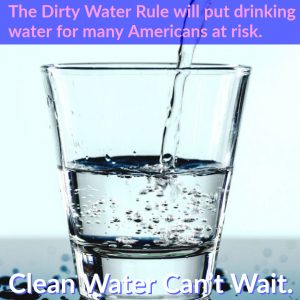Fight for Healthy Water: Stop the Dirty Water Rule
 Updated 3/13/19
Updated 3/13/19
Since President Trump took office in January of 2016, we all knew it was coming. From the beginning, Trump and former EPA Administrator Scott Pruitt were clear that repealing and replacing the Clean Water Rule was a priority.
Now, nearly two years later, it has finally happened. On Dec. 11, 2018, the Trump Administration proposed to repeal the Clean Water Rule and replace it with a Dirty Water Rule. The scope of the rollback, if allowed to happen, would be devastating for our nation’s waterways (see River Network President Nicole Silk’s op-ed in The Progressive explaining the threats).
This dangerous rollback is based on an extremely narrow interpretation of what waters are protected by the Clean Water Act that was previously rejected by the majority of the U.S. Supreme Court and the previous two administrations. The affect will be thousands of miles of streams and tens of millions of acres of wetlands will no longer be protected by the Clean Water Act. Although they’re not admitting it now, in 2017 the Environmental Protection Agency (EPA) estimated that 18% of streams and 51% of wetlands nationwide would not be protected under this newly proposed definition.
Excluding these waters does not make scientific, legal, public health, or fiscal sense. There are many examples around the country of wetlands and streams that may not always be flowing into downstream and nearby waters but still greatly impact the health of local waterways and provide water that we drink, habitat for fish and wildlife, and absorb and filter rain, flood waters, and pollution. Excluding these waters from Clean Water Act protections puts our drinking water, public health, recreation, and fishing at risk and makes us far less resilient to droughts and floods. What’s more, the proposal is specifically asking for comments on how to further weaken the Clean Water Act.
There are some important steps all clean water advocates and organizations can take to stop this dangerous rollback:
- Make sure your community and elected officials understand how risky this proposal is:
- Send a letter to the editor of your local paper and ask other members of your community to do the same, especially those who have a lot of influence with their neighbors and elected officials.
- Ask your local paper to do an editorial.
- Submit an op-ed to your local paper and ask influential members of your community to sign on with you.
- Share information about the rollback on social media – and encourage your friends, colleagues, and supporters to do the same.
- Provide real-world, local examples of waters that will be impacted if this rollback takes affect.
- EPA hosted only one official public hearing on 2/27/19. However, you can host your own town hall meeting and invite your elected officials to attend.
- Make sure the EPA hears from you and your fellow clean water advocates about how dangerous and unacceptable this rollback is:
- Send in – or sign-on to – comments to EPA. Contact April Ingle if you would like a comment letter template or are interested in signing on to a group letter.
- Raise the voice of the grassroots: send or forward action alerts and encourage others to weigh in.
If you are unsure where to start – or how to do – any of these steps, reach out to April Ingle, River Network’s Science and Policy Manager, and she will be happy to provide the support you need. Also, the Clean Water for All Coalition is a diverse Coalition working to defeat this proposal and provides updated resources on the Dirty Water Rule. Finally, make sure you follow us on Facebook and Twitter – we’ll post content there that we encourage you to use and share.





[…] continued to dismantle environmental protections and disavow science. A prime example is the Dirty Water Rule, proposed to limit the scope of the Clean Water Act, allowing additional pollution to threaten […]